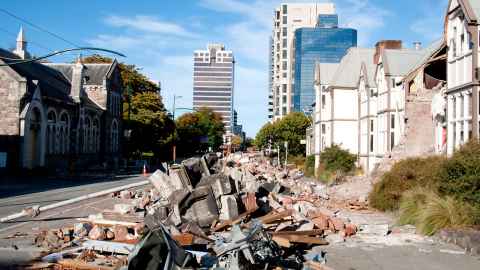Researchers shed light on Chch’s rebuild delays
21 February 2024
As the 13th anniversary of the Christchurch earthquake nears, the central city is still peppered with vacant sites and derelict buildings, impacting re-investment and successful regeneration, so what's the hold-up?

More than a decade after the 2011 earthquake, Christchurch’s CBD is still home to a few vacant sites, with research shedding light on some of the reasons why.
In the journal article, Challenges in post-earthquake recovery of damaged and neglected buildings in Christchurch CBD, University of Auckland Associate Professor (property) Olga Filippova and her co-authors say that despite the need to move ahead with the city’s regeneration, their research shows that the Council is limited in its legal powers to deal with unoccupied sites and buildings in poor states of repair (barrier sites).
Although the Building Act should govern this problem, it does not do so adequately.
“Our review identifies gaps in the regulatory powers to act on these sites, which are a barrier to the regeneration of the central city.
“Taking action involves meeting difficult definitions and tests under legislation and sometimes looking towards court proceedings,” says Associate Professor Filippova, who notes that the majority of barrier site owners have completed or are progressing action on the rebuild; however, a minority of owners are delaying progress on their sites.
Although emergency legislation, such as the Canterbury Earthquakes Recovery Act 2011 and Greater Christchurch Regeneration Act 2016 (now repealed), helped address short and mid-term recovery, the researchers say new legislative tools are needed to support local councils and give them the necessary powers required to take action against owners of barrier sites who refuse to cooperate.
This should be combined with a comprehensive survey of the local governments’ current recovery management capabilities.

The researchers also say valuable rebuild opportunities were missed early on while the cordon around the city centre was in place.
“In hindsight, the Crown should have exercised its powers to freeze or limit construction activity in the commercial sector outside of the central business district; this would have stopped developers on the periphery of the city centre and nearby suburbs acting to meet newly created demand from the displaced central city’s prime tenants, such as financial services and law firms.”
Delays in removing the cordon around central Christchurch, paired with uncertainties about a number of public sector projects that were supposed to encourage investment in the city, led to the loss of private investment and forced central city developments to compete with more affordable commercial and residential offerings outside the CBD, says Filippova.
“In light of the anniversary of Canterbury’s 2011 earthquake, our paper offers a reminder of the mammoth struggles the city has overcome, evident in its numerous modern and robust buildings, yet change is needed to ensure post-disaster rebuilds can progress without so many obstacles.”
Media contact
Sophie Boladeras I Media adviser
M: 022 4600 388
E: sophie.boladeras@auckland.ac.nz